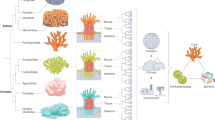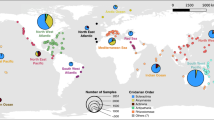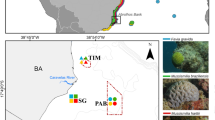Abstract
Ascidians are ecologically important components of marine ecosystems yet the ascidian microbiota remains largely unexplored beyond a few model species. We used 16S rRNA gene tag pyrosequencing to provide a comprehensive characterization of microbial symbionts in the tunic of 42 Great Barrier Reef ascidian samples representing 25 species. Results revealed high bacterial biodiversity (3 217 unique operational taxonomic units (OTU0.03) from 19 described and 14 candidate phyla) and the widespread occurrence of ammonia-oxidizing Thaumarchaeota in coral reef ascidians (24 of 25 host species). The ascidian microbiota was clearly differentiated from seawater microbial communities and included symbiont lineages shared with other invertebrate hosts as well as unique, ascidian-specific phylotypes. Several rare seawater microbes were markedly enriched (200–700 fold) in the ascidian tunic, suggesting that the rare biosphere of seawater may act as a conduit for horizontal symbiont transfer. However, most OTUs (71%) were rare and specific to single hosts and a significant correlation between host relatedness and symbiont community similarity was detected, indicating a high degree of host-specificity and potential role of vertical transmission in structuring these communities. We hypothesize that the complex ascidian microbiota revealed herein is maintained by the dynamic microenvironments within the ascidian tunic, offering optimal conditions for different metabolic pathways such as ample chemical substrate (ammonia-rich host waste) and physical habitat (high oxygen, low irradiance) for nitrification. Thus, ascidian hosts provide unique and fertile niches for diverse microorganisms and may represent an important and previously unrecognized habitat for nitrite/nitrate regeneration in coral reef ecosystems.
Similar content being viewed by others
Log in or create a free account to read this content
Gain free access to this article, as well as selected content from this journal and more on nature.com
or
Accession codes
References
Altschul SF, Gish W, Miller W, Myers EW, Lipman DJ . (1990). Basic local alignment search tool. J Mol Biol 215: 403–410.
Armstrong E, Yan L, Boyd KG, Wright PC, Burgess JG . (2001). The symbiotic role of marine microbes on living surfaces. Hydrobiologia 461: 37–40.
Barott KL, Rodriguez-Brito B, Janouškovec J, Marhaver KL, Smith JE, Keeling P et al (2011). Microbial diversity associated with four functional groups of benthic reef algae and the reef-building coral Montastraea annularis. Environ Microb 13: 1192–1204.
Behrendt L, Larkum Anthony WD, Trampe E, Norman A, Sørensen SJ, Kühl M . (2012). Microbial diversity of biofilm communities in microniches associated with the didemnid ascidian Lissoclinum patella. ISME J 6: 1222–1237.
Bengtsson J, Eriksson KM, Hartmann M, Wang Z, Shenoy BD, Grelet G-A et al (2011). Metaxa: a software tool for automated detection and discrimination among ribosomal small subunit (12S/16S/18S) sequences of archaea, bacteria, eukaryotes, mitochondria, and chloroplasts in metagenomes and environmental sequencing datasets. Anton Leeuw 100: 471–475.
Bright M, Bulgheresi S . (2010). A complex journey: transmission of microbial symbionts. Nat Rev Microbiol 8: 218–230.
Brochier-Armanet C, Boussau B, Gribaldo S, Forterre P . (2008). Mesophilic Crenarchaeota: proposal for a third archaeal phylum, the Thaumarchaeota. Nat Rev Microbiol 6: 245–252.
Cox G . (1986). Comparison of Prochloron from different hosts: I. Structural and ultrastructural characteristics. New Phytol 104: 429–445.
Cox GC, Hiller RG, Larkum AWD . (1985). An unusual cyanophyte, containing phycourobilin and symbiotic with ascidians and sponges. Mar Biol 89: 149–163.
Diaz MC, Ward BB . (1997). Sponge-mediated nitrification in tropical benthic communities. Mar Ecol Prog Ser 156: 97–107.
Donia MS, Fricke WF, Partensky F, Cox J, Elshahawi SI, White JR et al (2011). Complex microbiome underlying secondary and primary metabolism in the tunicate-Prochloron symbiosis. Proc Natl Acad Sci USA 108: E1423–E1432.
Dray S, Dufour A . (2007). The ade4 package: Implementing the duality diagram for ecologists. J. Stat Softw 22: 1–20.
Delsuc F, Brinkmann H, Chourrout D, Philippe H . (2006). Tunicates and not cephalochordates are the closest living relatives of vertebrates. Nature 439: 965–968.
Edgar RC, Haas BJ, Clemente JC, Quince C, Knight R . (2011). UCHIME improves sensitivity and speed of chimera detection. Bioinformatics 27: 2194–2200.
Erwin PM, López-Legentil S, Schuhmann PW . (2010). The pharmaceutical value of marine biodiversity for anti-cancer drug discovery. Ecol Econ 70: 445–451.
Erwin PM, Pineda MC, Webster N, Turon X, López-Legentil S . (2013). Small core communities and high variability in bacteria associated with the introduced ascidian Styela plicata. Symbiosis 59: 35–46.
Fan L, Reynolds D, Liu M, Stark M, Kjelleberg S, Webster NS et al (2012). Functional equivalence and evolutionary convergence in complex communities of microbial sponge symbionts. Proc Natl Acad Sci USA 109: E1878–E1887.
Fieseler L, Horn M, Wagner M, Hentschel U . (2004). Discovery of the novel candidate phylum “Poribacteria” in marine sponges. Appl Environ Microbiol 70: 3724–3732.
Folmer O, Black M, Hoeh W, Lutz R, Vrijenhoek R . (1994). DNA primers for amplification of mitochondrial cytochrome c oxidase subunit I from diverse metazoan invertebrates. Mol Mar Biol Biotechy 3: 294–299.
Freeman CJ, Thacker RW . (2011). Complex interactions between marine sponges and their symbiotic microbial communities. Limnol Oceanogr 56: 1577–1586.
Freeman MF, Gurgui C, Helf MJ, Morinaka BI, Uria AR, Oldham NJ et al (2012). Metagenome mining reveals polytheonamides as posttranslationally modified ribosomal peptides. Science 338: 387–390.
Giovannoni SJ, Stingl U . (2005). Molecular diversity and ecology microbial plankton. Nature 437: 343–348.
Goodbody I . (1974). The physiology of ascidians. Adv Mar Biol 12: 121–149.
Hallam SJ, Konstantinidis KT, Putnam N, Schleper C, Watanabe Y, Sugahara J et al (2006). Genomic analysis of the uncultivated marine crenarchaeote Cenarchaeum symbiosum. Proc Natl Acad Sci USA 103: 18296–18301.
Hernández-Mariné M, Turon X, Catalan J . (1990). A marine Synechocystis (Chroococcales, Cyanophyta) epizoic on didemnid ascidians from the Mediterranean Sea. Phycologia 29: 275–284.
Hirose E . (2000). Plant rake and algal pouch of the larvae in the tropical ascidian Diplosoma similis: an adaptation for verticaltransmission of photosynthetic symbionts Prochloron sp. Zool Sci 17: 233–240.
Hirose E, Hirose M . (2007). Morhological process of vertical transmission of photosymbionts in the colonial ascidian Trididemnum miniatum Kott, 1977. Mar Biol 150: 359–367.
Hirose E, Maruyama T . (2004). What are the benefits in the ascidian-Prochloron symbiosis? Endocyt Cell Res 15: 51–62.
Hirose E, Adachi R, Kuze K . (2006a). Sexual reproduction of the Prochloron-bearing ascidians, Trididemnum cyclops and Lissoclinum bistratum, in subtropical waters: seasonality and vertical transmission of photosymbionts. J Mar Biol Ass UK 86: 175–179.
Hirose E, Hirose M, Neilan BA . (2006b). Localization of symbiotic cyanobacteria in the colonial ascidian Trididemnum miniatum (Didemnidae, Ascidiacea). Zool Sci 23: 435–442.
Hirose E, Maruyama T, Cheng L, Lewin RA . (1996). Intracellular symbiosis of a photosynthetic prokaryote, Prochloron sp., in a colonial ascidian. Invertebr Biol 115: 343–348.
Hirose E, Ohtsuka K, Ishikura M, Maruyama T . (2004). Untraviolet absorption in ascidian tunic and ascidian-Prochloron symbiosis. J Mar Biol Assoc UK 84: 789–794.
Hirose E, Turon X, López-Legentil S, Erwin PM, Hirose M . (2012). First records of didemnid ascidians harboring Prochloron from the Caribbean Panama: genetic relationships between Caribbean and Pacific photosymbionts and host ascidians. Sys Biodivers 10: 435–445.
Hoffmann F, Larsen O, Thiel V, Rapp HT, Pape T, Michaelis W et al (2005). An anaerobic world in sponges. Geomicrobiol J 22: 1–10.
Hoffmann F, Radax R, Woebken D, Holtappels M, Lavik G, Rapp HT et al (2009). Complex nitrogen cycling in the sponge Geodia barretti. Environ Microb 11: 2228–2243.
Hoffmann F, Røy H, Bayer K, Hentschel U, Pfannkuchen M, Brümmer F et al (2008). Oxygen dynamics and transport in the Mediterranean sponge Aplysina aerophoba. Mar Biol 153: 1257–1264.
Huber JA, Mark Welch DB, Morrison HG, Huse SM, Neal PR, Butterfield DA et al (2007). Microbial population structures in the deep marine biosphere. Science 318: 97–100.
Huse SM, Welch DM, Morrison HG, Sogin ML . (2010). Ironing out the wrinkles in the rare biosphere through improved OTU clustering. Environ Microbiol 12: 1889–1898.
Kojima A, Hirose E . (2012). Transmission of cyanobacterial symbionts during embryogenesis in the coral reef ascidians Trididemnum nubilum and T. clinides (Didemnidae, Ascidiacea, Chordata). Biol Bull 222: 63–73.
Kojima A, Hirose E . (2010). Transfer of prokaryotic algal symbionts from a tropical ascidian (Lissoclinum punctatum) colony to its larvae. Zool Sci 27: 124–127.
Kott P . (1980). Algal-bearing didemnid ascidians in the Indo-West-Pacific. Mem Queensl Mus 20: 1–47.
Kott P . (1982). Didemnid-algal symbioses: host species in the Western Pacific with notes on the symbiosis. Micronesica 18: 95–127.
Kott P . (2001). The Australian Ascidiacea. Part 4, Aplousobranchia (3), Didemnidae. Mem Queensl Mus 47: 1–407.
Kühl M, Behrendt L, Trampe E, Qvortrup K, Schreiber U, Borisov SM et al (2012). Microenvironmental ecology of the chlorophyll b-containing symbiotic cyanobacterium Prochloron in the didemnid ascidian Lissoclinum patella. Front Microbiol 3: 73–90.
Kwan JC, Donia MS, Han AW, Hirose E, Haygood MG, Schmidt EW . (2012). Genome streamlining and chemical defense in a coral reef symbiosis. Proc Natl Acad Sci USA 109: 20655–20660.
Lambert G . (2005). Ecology and natural history of the protochordates. Can J Zool 83: 34–50.
Lema KA, Willis BL, Bourne DG . (2012). Corals form characteristic associations with symbiotic nitrogen-fixing bacteria. Appl Environ Microbiol 78: 3136–3144.
Lodwig EM, Hosie AHF, Bourdès A, Findlay K, Allaway D, Karunakaran R et al (2003). Amino-acid cycling drives nitrogen fixation in the legume-Rhizobium symbiosis. Nature 422: 722–726.
López-Legentil S, Song B, Bosch M, Pawlik JR, Turon X . (2011). Cyanobacterial diversity and a new Acaryochloris-like symbiont from Bahamian sea-squirts. PLoS One 6: e23938.
López-Legentil S, Turon X . (2005). How do morphotypes and chemotypes relate to genotypes? The colonial ascidian Cystodytes (Polycitoridae). Zool Scr 34: 3–14.
Martínez-García M, Díaz-Valdés M, Wanner G, Ramos-Esplá A, Antón J . (2007). Microbial community associated with the colonial ascidian Cystodytes dellechiajei. Environ Microbiol 9: 521–534.
Martínez-García M, Koblížek M, López-Legentil S, Antón J . (2011). Epibiosis of oxygenic phototrophs containing chlorophylls a, b, c, and d on the colonial ascidian Cystodytes dellechiajei. Microb Ecol 61: 13–19.
Martínez-García M, Stief P, Díaz-Valdés M, Wanner G, Ramos-Esplá A, Dubilier N et al (2008). Ammonia-oxidizing Crenarchaeota and nitrification inside the tissue of a colonial ascidian. Environ Microbiol 10: 2991–3001.
Merbt SN, Stahl DA, Casamayor EO, Martí E, Nicol GW, Prosser JI . (2012). Differential photoinhibition of bacterial and archaeal ammonia oxidation. FEMS Microbiol Lett 327: 41–46.
McDonald D, Price MN, Goodrich J, Nawrocki EP, DeSantis TZ, Probst A et al (2012). An improved Greengenes taxonomy with explicit ranks for ecological and evolutionary analyses of bacteria and archaea. ISME J 6: 610–618.
Moss C, Green DH, Pérez B, Velasco A, Henríquez R, McKenzie JD . (2003). Intracellular bacteria associated with the ascidian Ecteinascidia turbinata: phylogenetic and in situ hybridisation analysis. Mar Biol 143: 99–110.
Muscatine L, Porter JW . (1977). Reef corals: mutualistic symbioses adapted to nutrient-poor environments. BioScience 27: 454–460.
Münchhoff J, Hirose E, Maruyama T, Sunairi M, Burns BP, Neilan BA . (2007). Host specificity and phylogeography of the prochlorophyte Prochloron sp., an obligate symbiont in didemnid ascidians. Environ Microbiol 9: 890–899.
Pardy RL, Lewin RA . (1981). Colonial ascidians with Prochlorophyte symbionts: evidence for translocation of metabolites from alga to host. Bull Mar Sci 31: 817–823.
Paul VJ, Ritson-Williams R . (2008). Marine chemical ecology. Nat Prod Rep 25: 662–695.
Pawlik JR . (2011). The chemical ecology of sponges on Caribbean reefs: natural products shape natural systems. Bio Science 61: 888–898.
Preston CM, Wu KY, Molinski TF, DeLong EF . (1996). A psychrophilic crenarchaeon inhabits a marine sponge: Cenarchaeum symbiosum gen. nov., sp. nov. Proc Natl Acad Sci USA 93: 6241–6246.
Pérez-Matos AE, Rosado W, Govind NS . (2007). Bacterial diversity associated with the Caribbean tunicate Ecteinascidia turbinata. A van Leeuw J Microb 92: 155–164.
Pérez-Portela R, Bishop JDD, Davis AR, Turon X . (2009). Phylogeny of the families Pyuridae and Styelidae (Stolidobranchiata, Ascidiacea) inferred from mitochondrial and nuclear DNA sequences. Mol Phylogenet Evol 50: 560–570.
Raina JB, Dinsdale EA, Willis BL, Bourne DG . (2010). Do the organic sulfer compounds DMSP and DMS drive coral microbioal associations? Trends Microbiol 18: 101–108.
Rath CM, Janto B, Earl J, Ahmed A, Hu FZ, Hiller L et al (2011). Meta-omic characterization of the marine invertebrate microbial consortium that produces the chemotherapeutic natural product ET-743. ACS Chem Biol 6: 1244–1256.
Roesch LFW, Fulthorpe RR, Riva A, Casella G, Hadwin AKM, Kent AD et al (2007). Pyrosequencing enumerates and contrasts soil microbial diversity. ISME J 1: 283–290.
Rowan R . (1998). Diversity and ecology of zooxanthellae on coral reefs. J Phycol 34: 407–417.
Schloss PD, Gevers D, Westcott SL . (2011). Reducing the effects of PCR amplification and sequencing artifacts on 16S rRNA-based studies. PLoS One 6: e27310.
Schloss PD, Westcott SL . (2011). Assessing and improving methods used in operational taxonomic unit-based approaches for 16S rRNA gene sequence analysis. App Environ Microbiol 77: 3219–3226.
Schloss PD, Westcott SL, Ryabin T, Hall JR, Hartmann M, Hollister EB et al (2009). Introducing mothur: open-source, platform-independent, community-supported software for describing and comparing microbial communities. App Environ Microbiol 75: 7537–7541.
Schmidt EW, Donia MS . (2010). Life in cellulose houses: symbiotic bacterial biosynthesis of ascidian drugs and drug leads. Curr Opin Biotech 21: 827–833.
Schmidt EW, Nelson JT, Rasko DA, Sudek S, Eisen JA, Haygood MG et al (2005). Patellamide A and C biosynthesis by a microcin-like pathway in Prochloron didemni, the cyanobacterial symbiont of Lissoclinum patella. Proc Natl Acad Sci USA 102: 7315–7320.
Schmitt S, Tsai P, Bell J, Fromont J, Ilan M, Lindquist N et al (2012). Assessing the complex sponge microbiota: core, variable and species-specific bacterial communities in marine sponges. ISME J J6: 564–576.
Schuett C, Doepke H, Groepler W, Wichels A . (2005). Diversity of intratunical bacteria in the tunic matrix of the colonial ascidian Diplosoma migrans. Helgoland Mar Res 59: 136–140.
Shenkar N, Swalla BJ . (2011). Global diversity of Ascidiacea. PLoS One 7: e20657.
Simister RL, Deines P, Botté ES, Webster NS, Taylor MW . (2012). Sponge-specific clusters revisited: a comprehensive phylogeny of sponge-associated microorganisms. Environ Microbiol 14: 517–524.
Smith EP, Van Belle G . (1984). Nonparametric estimation of species richness. Biometrics 40: 119–129.
Southwell MW, Weisz JB, Martens CS, Lindquist N . (2008). In situ fluxes of dissolved inorganic nitrogen from the sponge community on Conch Reef, Key Largo, Florida. Limnol Oceanogr 53: 986–996.
Spang A, Hatzenpichler R, Brochier-Armanet C, Rattei T, Tischler P, Spieck E et al (2010). Distinct gene set in two different lineages of ammonia-oxidizing archaea supports the phylum Thaumarchaeota. Trends Microbiol 18: 331–340.
Stefaniak L, Lambert G, Gittenberger A, Zhang H, Lin S, Whitlatch RB . (2009). Genetic conspecificity of the worldwide populations of Didemnum vexillum Kott, 2002. Aquat Invasions 4: 29–44.
Sunagawa S, Woodley CM, Medina M . (2010). Threatened corals provide underexplored microbial habitats. PLoS One 5: e9554.
Tait E, Carman M, Sievert SM . (2007). Phylogenetic diversity of bacteria associated with ascidians in Eel Pond (Woods Hole, Massachusetts, USA). J Exp Mar Biol Ecol 342: 138–146.
Tarjuelo I, Posada D, Crandall KA, Pascual M, Turon X . (2004). Phylogeography and speciation of colour morphs in the colonial ascidian Pseudodistoma crucigaster. Mol Ecol 13: 3125–3136.
Taylor MW, Radax R, Steger D, Wagner M . (2007). Sponge-associated microorganisms: evolution, ecology, and biotechnological potential. Microbiol Mol Biol Rev 71: 295–347.
Taylor MW, Tsai P, Simister RL, Deines P, Botte E, Ericson G et al (2013). “Sponge-specific” bacteria are widespread (but rare) in diverse marine environments. ISME J 7: 438–443.
Turon X, López-Legentil S, Banaigs B . (2005). Cell types, microsymbionts, and pyridoacridine distribution in the tunic of three color morphs of the genus Cystodytes (Ascidiacea, Polycitoridae). Invertebr Biol 124: 355–369.
Usher KM, Toze S, Fromont J, Kuo J, Sutton DC . (2004). A new species of cyanobacterial symbiont from the marine sponge Chondrilla nucula. Symbiosis 36: 183–192.
Vermeij MJA, Bak RPM . (2002). How are coral populations structured by light? Marine light regimes and the distribution of Madracis. Mar Ecol Prog Ser 233: 105–116.
Ward BB, Capone DG, Zehr JP . (2007). What’s new in the nitrogen cycle? Oceanography 20: 101–109.
Webb KL, DuPaul WD, Wiebe W, Sottile W, Johannes RE . (1975). Enewetak (Eniwetok) Atoll: aspects of the nitrogen cycle on a coral reef. Limnol Oceanogr 20: 198–219.
Webster NS, Taylor MW . (2012). Marine sponges and their microbial symbionts: love and other relationships. Environ Microbiol 14: 335–346.
Webster NS, Taylor MW, Behnam F, Lücker S, Rattei T, Whalan S et al (2010). Deep sequencing reveals exceptional diversity and modes of transmission for bacterial sponge symbionts. Environ Microbiol 12: 2070–2082.
Wilkinson CR . (1983). Net primary productivity in coral reef sponges. Science 219: 410–412.
Yokobori S, Kurabayashi A, Neilan BA, Maruyama T, Hirose E . (2006). Multiple origins of the ascidian-Prochloron symbiosis: molecular phylogeny of photosymbiotic and non-symbiotic colonial ascidians inferred from 18S rDNA sequences. Mol Phylogenet Evol 40: 8–19.
Acknowledgements
This research was funded by the Marie Curie International Reintegration Grant FP7-PEOPLE-2010-RG 277038 (within the 7th European Community Framework Program), the Spanish Government projects CTM2010-17755 and CTM2010-22218 and the Catalan Government grant 2009SGR-484 for Consolidated Research Groups. NSW was funded through an Australian Research Council Future Fellowship (FT1200100480).
Author information
Authors and Affiliations
Corresponding author
Ethics declarations
Competing interests
The authors declare no conflict of interest.
Additional information
Supplementary Information accompanies this paper on The ISME Journal website
Supplementary information
Rights and permissions
About this article
Cite this article
Erwin, P., Pineda, M., Webster, N. et al. Down under the tunic: bacterial biodiversity hotspots and widespread ammonia-oxidizing archaea in coral reef ascidians. ISME J 8, 575–588 (2014). https://doi.org/10.1038/ismej.2013.188
Received:
Revised:
Accepted:
Published:
Issue date:
DOI: https://doi.org/10.1038/ismej.2013.188
Keywords
This article is cited by
-
The impacts of ocean acidification, warming and their interactive effects on coral prokaryotic symbionts
Environmental Microbiome (2023)
-
Prokaryotic symbiont communities in three ascidian species introduced in both Ireland and New Zealand
Environmental Science and Pollution Research (2023)
-
Integrating novel tools to elucidate the metabolic basis of microbial symbiosis in reef holobionts
Marine Biology (2021)
-
The bacterial composition associated with Atriolum robustum, a common ascidian from Xisha coral reef, China
Symbiosis (2021)
-
Taxonomic Composition and Biological Activity of Bacterial Communities Associated with Marine Ascidians from Andaman Islands, India
Applied Biochemistry and Biotechnology (2021)



